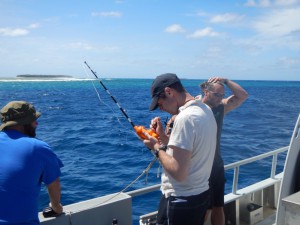CTD (Conductivity, Temperature, Depth)
The water column is not merely an obstacle to overcome when collecting sub-aqueous sediment cores. There is a great deal we can learn about from the water that is of vital importance to understanding both the depositional environment and the relationship of that environment to the larger Earth systems. The CTD (Conductivity, Temperature, and Depth) is one such device in our toolkit that allows us to quantify certain physical properties of the water ultimately aiding in our interpretation of the site.
Conductivity refers to how condutive the water is to electrical current. This serves as a proxy* for salinity. More than simply knowing how fresh or salty a body of water of is, we’re interested in identifying the halocline. The halocline is a distinct transition in the salinity of the water column (from lower above and higher below). This informs us as to how mixed the bottom water is with the top water, how dynamic the site is at depth.
Similar to the Halocline is the Thermocline. Barring any geothermic influences water should decrease in temperature as depth increases. The thermocline is an abrubt transition from less dense warm water, to denser (and saltier in a marine setting) colder water. If there is no clear thermocline then again, the site is likely experiencing a high degree of mixing and flow.
The CTD gives us the temperature and salinity values as profiles; measurements plotted by depth. In order to do this the probe must have a way of calculating its depth through the water column. Unlike the Chirp and Echo sounders that use sound pulses and time/distance conversions to calculate depth the CTD has an internal pressure sensor that gives a precise depth measurements as it falls through the water column.
In addition to the Conductivity and Temperature measurements the CTD also computer sound velocity.
The speed of sound varies depending on the medium through which is passes. The speed of sound at sea level is different than at the top of Mount Everest or inside an airplane or city bus owing to the various densities (and the associated acousitc impedence) of the atmosphere in those scenarios. Water is denser than air, and colder saltier water is denser than warm fresh water.
Sonar systems (like the Chirp, Hydrolite, and even our depth guns and fish finders) all use a fixed speed of sound to calculate depth. Often that value is 1500m/s as this is an acceptable value for most marine environments. Yet in order to develop the precise bathymetric models that we use we need a more accurate sound velocity value specific to the location we’re working in at the time that we’re working. The CTD gives us this value. If the sound is faster or slower than 1500m/s then the depths derived from the Two-Way Travel Time calculations are inaccurate, unless the correct sound velocity is used.
Dissolved Oxygen (DO) is another physical property of the water that CTDs often measure. DO refers to the amount of oxygen in the water and speaks to how hypoxic (low Oxygen) or anoxic (no oxygen) the site may be. Low oxygen levels are a sign of little to no mixing in the water column and suggests minimal bioturbation and a high degree of organic preservation.

